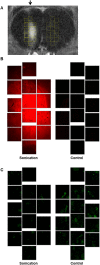Localized Down-regulation of P-glycoprotein by Focused Ultrasound and Microbubbles induced Blood-Brain Barrier Disruption in Rat Brain
- PMID: 27510760
- PMCID: PMC4980618
- DOI: 10.1038/srep31201
Localized Down-regulation of P-glycoprotein by Focused Ultrasound and Microbubbles induced Blood-Brain Barrier Disruption in Rat Brain
Abstract
Multi-drug resistant efflux transporters found in Blood-Brain Barrier (BBB) acts as a functional barrier, by pumping out most of the drugs into the blood. Previous studies showed focused ultrasound (FUS) induced microbubble oscillation can disrupt the BBB by loosening the tight junctions in the brain endothelial cells; however, no study was performed to investigate its impact on the functional barrier of the BBB. In this study, the BBB in rat brains were disrupted using the MRI guided FUS and microbubbles. The immunofluorescence study evaluated the expression of the P-glycoprotein (P-gp), the most dominant multi-drug resistant protein found in the BBB. Intensity of the P-gp expression at the BBB disruption (BBBD) regions was significantly reduced (63.2 ± 18.4%) compared to the control area. The magnitude of the BBBD and the level of the P-gp down-regulation were significantly correlated. Both the immunofluorescence and histologic analysis at the BBBD regions revealed no apparent damage in the brain endothelial cells. The results demonstrate that the FUS and microbubbles can induce a localized down-regulation of P-gp expression in rat brain. The study suggests a clinically translation of this method to treat neural diseases through targeted delivery of the wide ranges of brain disorder related drugs.
Figures






References
-
- Sheikov N. et al.. Brain arterioles show more active vesicular transport of blood-borne tracer molecules than capillaries and venules after focused ultrasound-evoked opening of the blood-brain barrier. Ultrasound in medicine & biology 32, 1399–1409, 10.1016/j.ultrasmedbio.2006.05.015 (2006). - DOI - PubMed
Publication types
MeSH terms
Substances
LinkOut - more resources
Full Text Sources
Other Literature Sources
Miscellaneous

